Pragati: Path to Future
 Saumili Dutta
Saumili DuttaTable of contents
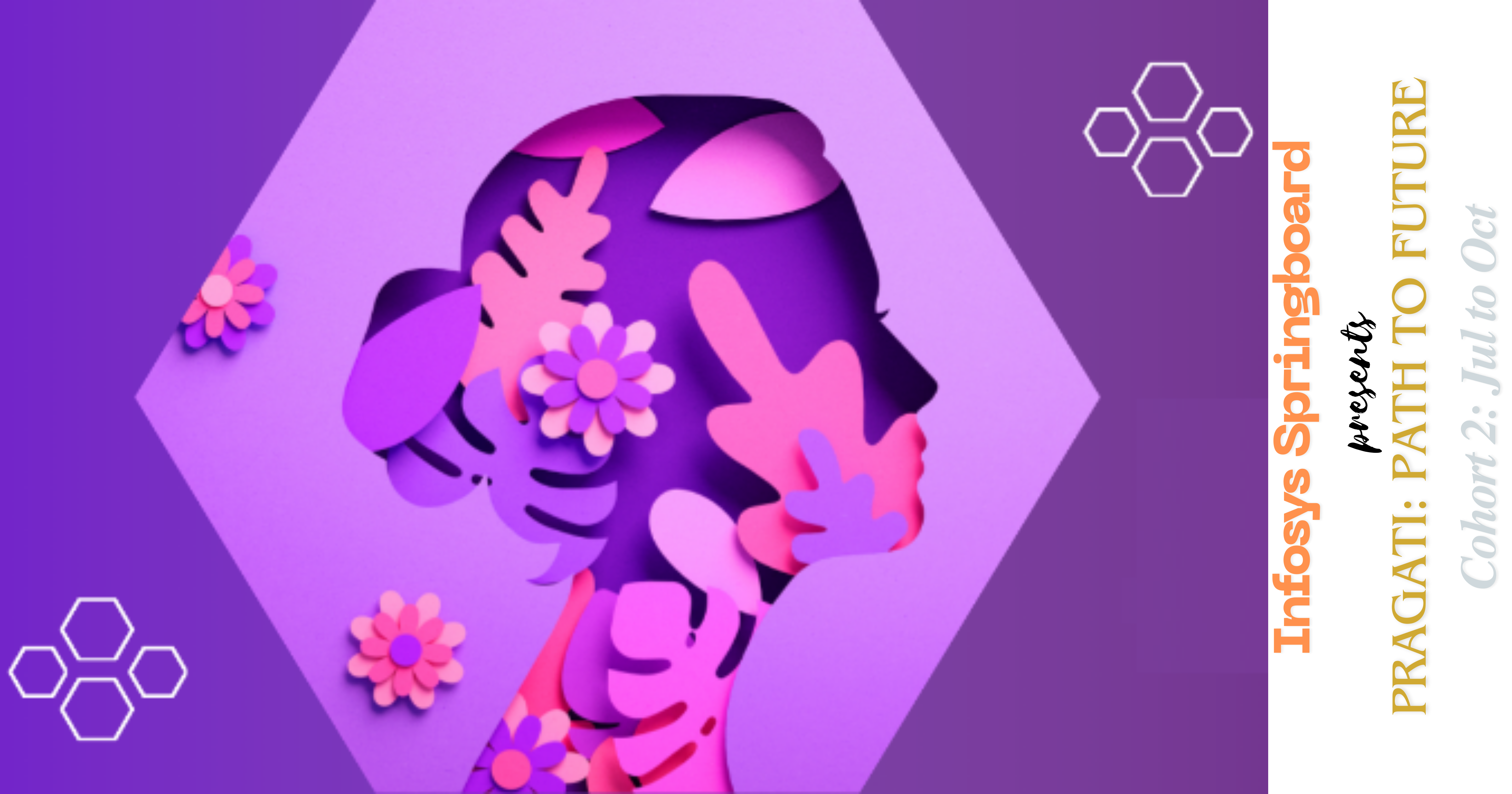
Introduction
What is Pragati?
Pragati: Path to Future is a 12 week long program designed exclusively for women to improve their personality aspects, stay updated with latest technology, GenAI fluency, industry engagement and professional advancements. The last week will be an in person workshops on the Infosys DC.
How to register?
You need to sign up in Infosys Springboard platform and when the cohort registrations open you’ll receive a mail like the one shown below.
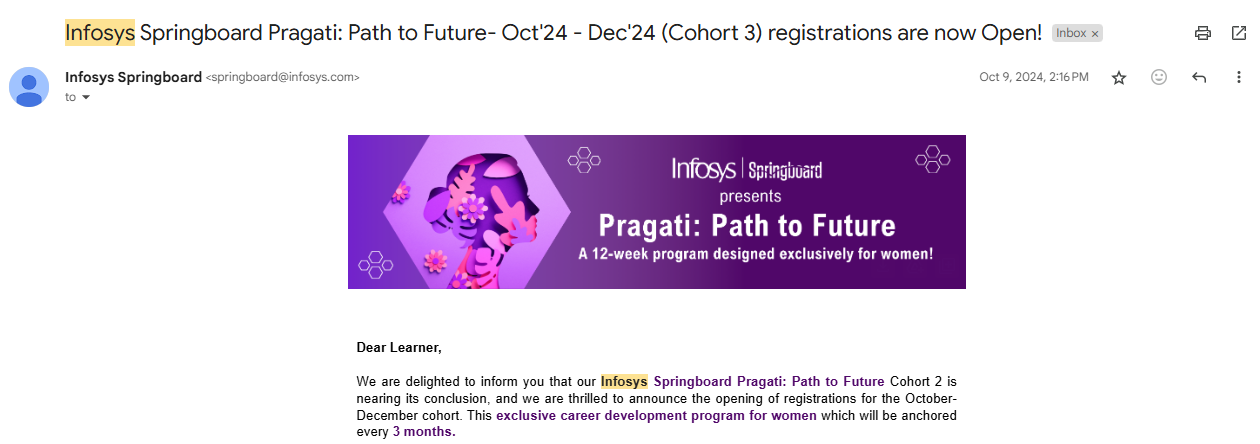
You might have a question that the cohort 3 registrations are closed now, what can I do?
Simply just sign up in the springboard platform and once the cohort 4 registrations are live, you’ll receive a mail most probably either end of December or start of January.
Tip: Actively check your email ids during that period!
Which documents are needed?
If you are a college student then you will be required to submit a NOC [No object certificate] during registration which is nothing but a signed letter from either your HOD or principal saying that the college permits you to undergo the training. For your reference, I have provided a sample NOC.
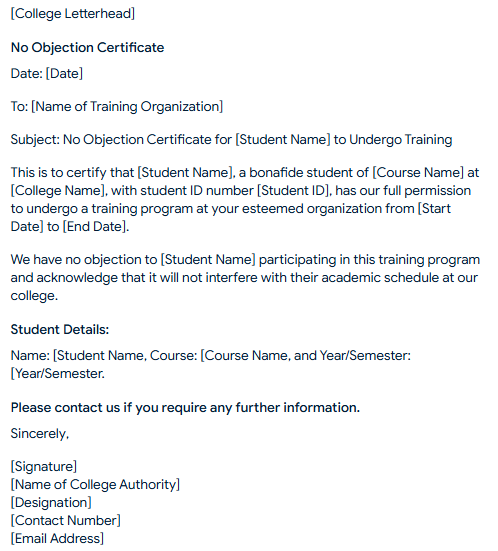
How to know you have been accepted?
You’ll receive a mail after the registration closes stating that you have been selected. It will look something like the one attached below.
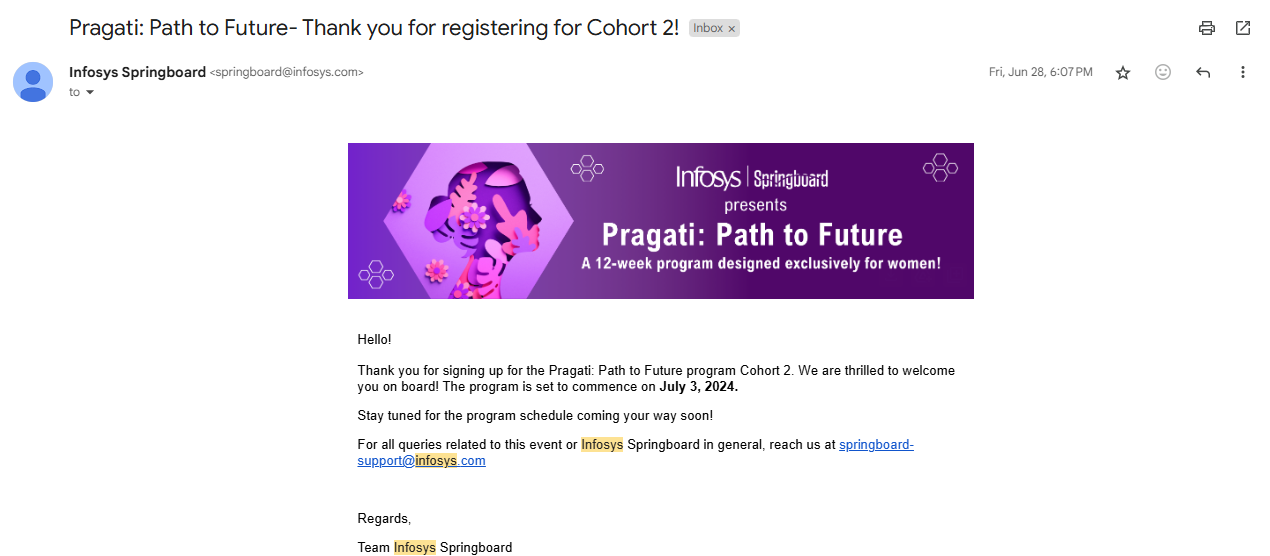
What if i face a problem?
If you have any problem, you can contact the team at springboard-support@infosys.com but always remember not to sent too many mails or mails with issue not related to Pragati.
Benefit
This can be added as an experience in the resume and a certificate will be provided given that all three criteria’s are met:
80% attendance [online + offline]
10 courses completed
2 certifications completed
Online modules
Online modules start with orientation session where the accepted trainees will be invited to join a meet and will be introduced on how to use the springboard platform and even a chat with the previous cohort trainees.
Then once the welcome sessions are done, the schedule of each modules will be sent through mails. Once the current module is complete, the schedule of the next one will be sent and so on.
You will also be given access to the Pragati channel which will have all the links to the courses required to complete for the program. To find the channel, go to the channels and search for Pragati: Path to Future (cohort)
In cohort 2, we had 5 modules and they are as follows:
Artificial Intelligence
Personality Foundry
Java and Python Essentials
English Enigma
Fundamentals of DBMS
Each module has courses, live sessions to attend and certification exams
Artificial Intelligence
In this module, we were introduced to Artificial Intelligence, why AI is required, what is it, what are its branches, what is Machine Learning, the algorithms and a demo of how to train a model and get efficient results.
Next was Deep Learning session where there case studies to show how it can be useful in certain situations. Moving on to what it is and the different DL algorithms, its applications, frameworks and its product.
The last one was NLP, discussions on what it is, its applications, tools and frameworks required.
Personality Foundry
This module was interesting as we were learning on how to be confident, tips on how to enhance personality, how to effectively communicate with teams, the personality enigma, the influencer matrices and mastering the leadership competencies.
Java and Python Essentials
This module introduced us to both JAVA and Python from scratch and it was on us to choose any one language and advance ourselves. I chose python and revised from scratch and OOPs and move on to data structures.
English Enigma
This module is helpful to those who are not so fluent in English and will help to improve their fluency while speaking and also there were courses on both verbal and non-verbal communications.
Fundamentals of DBMS
This module focused on the need of DBMS and taught the different types of DBMS commands, normalization, modular query writing, joins and many more advance topics like writing subqueries and DB design.
On campus modules
Day 1
Springboard Demo
There was a short demo of Infosys Springboard, what it is doing, how it is providing education free of cost and the features of the platforms. I liked one innovation that is the springboard maker lab on wheels and the several learning opportunities especially for women.
We also discussed on five things on which an individual should work on to land a job successfully in 2024 and they are Technology, Soft skills, Communication, Attitude and Networking.
Generative AI
We had a discussion on the History of AI that is how AI has evolved from 1950s and now it has become one of the integral part of our life. Wherever you see is AI, the Alexa that you talk to is AI, the self driving car is one of its application, the smart home devices, the smartwatch, etc.
Then the discussion moved on to OpenAI, who were the initial founders and the reason behind why Elon musk left. I hope you all know that Microsoft invested in OpenAI but on the other hand, Google collaborated with Deepmind.
There are seven stages of development of GenAI:
Rule-Based Systems
Context Awareness
Domain-Specific Expertise
Reasoning Systems
Artificial General Intelligence (AGI)
Artificial Super Intelligence (ASI)
Singularity
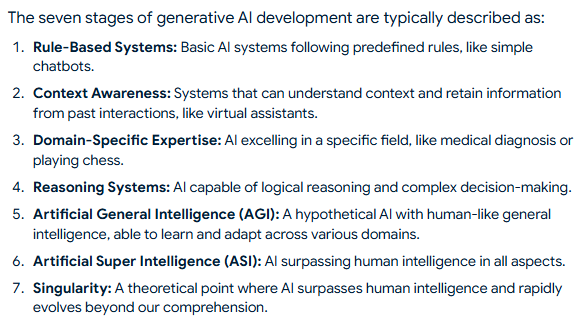
You might have a question, will the Terminator movie turn to reality?
Honestly I have the same question as well but we humans consider ourselves to be the superior being so somewhere the development might stop or else yeah we might be fighting against AI someday in the future.
Lead the change
Before I start off with change and all, did you ever know before 2019 that some situation like Covid may arise and we will be in quarantine and lockdown?
No, right?! (Well don’t believe in the astrologists, they know everything and have said only after it happened.)
Then, what happened? Those working in our families, you saw them working from home and even they didn’t know that that was possible in their profession. But we all accepted the change, didn’t we?
We all live in a VUCA world and it is important to understand what is it?
V = Volatility means that there are frequent, rapid and significant changes occurring in a short period of time.
U = Uncertainty includes the unpredictable events and outcomes
C = Complexity means the issues and factors that make it complex
A = Ambiguity means the lack of clarity
So, to live in this ever-changing and ever-evolving world, we need to change ourselves but we do not do so and what is the reason behind that?
The answer lies in the 3 C’s - Confidence, Competencies and Control
When we become confident in some skills or abilities we do not want to change cause trying out new things might make us less confident
Once we’re comfortable with our skills, we find it difficult to learn new ones and achieving seems daunting
As we change we fear the loss of control over certain situations and people are
Day 2
Articulation skills
What does articulation means?
Simply put, articulation is the ability to express your thoughts clearly with correct grammar, pace, pronunciation, pause while keeping it simple.
Why can’t people articulate?
Often the fear of judgement, not being able to speak fluently and the language barriers hinders our ability to articulate.
What are the opportunities to articulate?
- Find 3 opportunities daily to talk with someone: it can be anyone like either your parents, friends, seniors or maybe yourself in front of mirror
What are required to be good in articulation skill?
Structured speech
Speech should have 3 parts- Intro, body and conclusion
Know your audience
Knowing the audience is very important since then the speech can be properly
Voice modulation
There are five important things to keep in mind for this:
Volume should be in mid-range
Pace should be balanced, not too fast or too slow
Pitch should be right and should go as per the emphasis and tone delivery
Pause is important to make it more understandable as it adds to the tone
Reducing filler words like “hmm, yeah, oh” can have a better impact
Body Language
There are five important things to keep in mind for this:
Maintaining eye contact doesn’t mean you have to stare at someone but rather look at something so the audience feels you are looking at them
Smiling makes you look approachable
Erect posture makes you look interested
Hand gestures should accompany the speech [imagine holding a football]
Face the audience
Listening
There is a difference between hearing and listening, hearing happens involuntarily and listening happens voluntarily. You will hear sounds but what you’re paying attention to and trying to understand is listening.
Dealing with emotions
It is very important to deal with emotions cause wrong emotions at wrong times and wrong places might make a mess and leave a bad impression unless the people are empathetic enough.
How people show feelings can differ in four ways and they are:
sympathy, which is to feel pity for someone
empathy, which is to understand the feeling of another
apathy, which is to not feel anything or lack of interest
antipathy, which is to have strong dislike or anti feeling
Campus Tour
We were interested for this particular session and see the workplace where we might be working one day. But the interiors of the Kolkata Infosys DC is awesome. A couple of things that I really liked is a separate washroom for Handicapped and transgender, dedicated cabin for a new mom, dorm and the quiet room. We also saw the interview room, the canteen, playing area and conference rooms.
Assertiveness skills
There are four types of communication Styles :
Passive
Aggressive
Passive aggressive
Assertive
I will talk more about it later in some other blog but it is very important to learn to say no to things and to say no without saying no.
Day 3
Presentation skills
A good presentation is all about the 3 P’s - Plan, Prepare and Present.
Plan: planning is all about who is going to present, what are they going to present, when, where, how and why
Prepare: Prepare includes preparing the deck
Present: To go up in front of everyone and speak
Present
To make it a good presentation, each slide should have 5 points and 7 words max in a point
The content should be divided into Introduction, body and Conclusion
Introduction- You can start introduction with any one option which includes question, joke, story or anecdote.
Body- Do not read it off slide nor drag on one topic and try to include the doubts clarification and quiz
Conclusion- Ask from audience
A few points to remember while presenting:
Check body language
Ironed shirt and trouser
Avoid Indianism*
Do not touch hair or face and hair shouldn’t fall on face
Have plain accent
Group Activity
Our listening skill for the presentation session was put to test through the group activity. We were randomly paired and told to choose a topic, prepare within 10 mins and present it in front of everyone after which we were judged.
Transformation in Tech
We had a discussion on the recent tech trends which includes Devops, MLOps, Cybersecurity, Cloud Computing, Open Source, Low code or No code, AI/ML, etc.
Day 4
Strategic thinking & Decision Making
There can be four types of decision making system:
Monarchy: People are divided into groups and are told to come up with ideas, whoever idea is liked by monarchy will be followed
Dictatorship: Whatever the leader thinks of that will be followed, no other decisions are taken into consideration
Majority wins: Everyone comes up with a decision, whoever’s get the most vote wins and is followed
Democracy: Decisions are made by the people, either directly or through elected representatives
Group Activity
We had two activities- giving a color to days and crafting out solution in a given situation.
The first activity was to pick a color and assign to the days of the week along with valid reason. We all shared the color and the reason behind it. One important lesson learnt through this is that everyone has different perspective and thoughts and we should respect it even if it doesn’t match with ours.
The next activity was we were given a situation and a deadline, we have to come up with a strategy based on which the client will give the project to any one team. We followed the agile methodology starting from advertising from our previous work to following sdlc and also marketing the product. We had three votes in our favor but according to Manasa ma’am we made two crucial mistake:
We didnt research on the client
We had a very rigid plan, so if something went off, we would fall apart.
I will keep this in mind the next time I’m in a similar situation.
Power of networking
This was really an insightful one where we got to talk with folks with industry experience and gain a lot of tips from them.
Day 5
Interview Interfacing
A few tips that I got to know:
Greet the interviewers and sit only when asked to
Ask for feedback
If its online, there shouldn’t be any background noise or people in background
Look at the camera
Interviewers should be able to see till shoulder
Proper lighting in the room
BE honest with resume
Put only that you know
Choose a hobby that you can tell about
Research about the company and the interviewer
Try to ask some question to the interviewer
Prepare the answer to “Why should we choose you?“
Feedback essentials & Experience sharing
We shared our feedback on the whole program, how it has helped us and we even provided our testimonials with a photo session.
Experience
When I reached the campus on the first day, my jaws dropped seeing the huge building. I had to go through security checks, register my name and collect my visitors ID card. The guards guided us the very 1st day and once we knew, we were told be at specific places as per the schedule along with someone from Infosys. Then during the lunch, our mentors used to sit with us and have food and certainly share a lot of experiences. Though the last day I could not attend due to an exam but I really loved the time spent there. Throughout the four days, I actively took part in interactions, listened to the instructors, observed what happened around, listened actively to them and took notes. This was a one-in-a-lifetime experience.
Sign up in Springboard: https://infyspringboard.us.onwingspan.com/web/
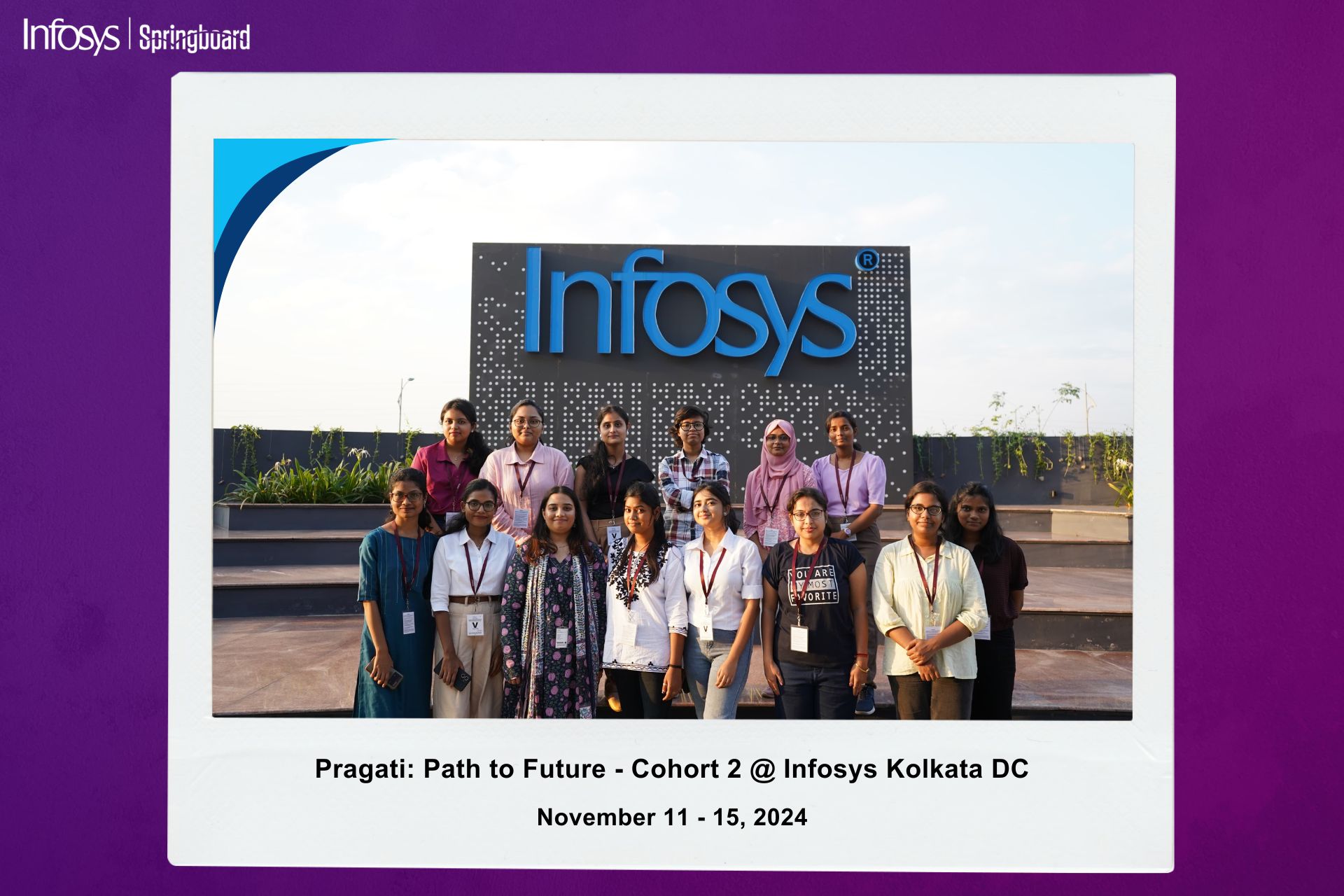
* Indianism refers to words in English language used in India only
Subscribe to my newsletter
Read articles from Saumili Dutta directly inside your inbox. Subscribe to the newsletter, and don't miss out.
Written by
